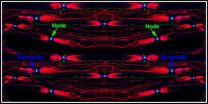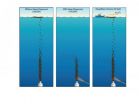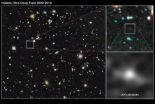(Press-News.org) EAST LANSING, Mich. — It's commonly known, at least among microbiologists, that microbes have an additional option to living or dying — dormancy.
Dormant microbes are less like zombies and more like hibernating bears. What isn't known, however, is how large numbers of dormant microorganisms affect the natural environments when they act as microbial seed banks. In the current issue of Nature Reviews: Microbiology, Jay Lennon, Michigan State University assistant professor of microbiology and molecular genetics, examines the cellular mechanisms that allow microbes to hibernate and addresses the implications they can have on larger ecosystems such as soil, oceans, lakes and the human body.
"Only a tiny fraction is metabolically active at any given time," said Lennon, who is affiliated with MSU's Kellogg Biological Station and MSU's AgBioResearch. "How would our environment be altered, in terms of carbon emissions, nutrient cycling and greenhouse gases such as nitrous oxide, by dramatic increases or decreases in the dormancy of microbes?"
Dormancy is a reversible state of low metabolic activity that organisms enter when they encounter hard times, such as freezing temperatures or starvation. Unlike plants that follow predictable growth cycles, microbes don't have to follow a linear progression. They could be growing, experience distress and go back to sleep. Once conditions change, they could start growing again without having to go through a full cycle.
"However, it does take a certain level of commitment, a certain energy investment to make it happen," Lennon said. "Just as people don't run out and winterize their homes if it gets cool in August, microbes want to be sure that truly hard times have set in before shifting into a dormant phase."
Consider that 90 percent of soil microorganisms are typically dormant and only half of bacterial species are active. Lennon and his co-author, Stuart Jones at the University of Notre Dame, theorize that dormancy and the presence of such large reservoirs of microbial "seed banks" have important implications for biodiversity and the stability and functioning of ecosystem services.
"The idea of a microbial seed bank is a rather novel concept, but from our research we found that dormancy and seed banks are prevalent in most ecosystems." Lennon said. "What's fascinating is that there's only a small fraction that are active, which means there's a large reservoir that could potentially be activated at any given time."
Dormancy and the seed bank effect make microbes more resilient and could play key roles in microbial biodiversity as species migrate or simply remain mostly dormant over extended periods, he added. Dormancy could also help explain the sudden outbreak of diseases, he said, perhaps sparked by some change in the environment.
"One-third of world's population carries dormant tuberculosis microbes," he said. "Obviously, you can live a long time with the dormant cell in your body, but it's important to understand what can trigger its reanimation or what maintains its dormancy."
As Lennon continues his research, he is particularly interested in identifying the triggers of dormancy and activation cycles as well as how climate change affects these processes.
INFORMATION:
Lennon's research is funded in part by the National Science Foundation.
Michigan State University has been working to advance the common good in uncommon ways for more than 150 years. One of the top research universities in the world, MSU focuses its vast resources on creating solutions to some of the world's most pressing challenges, while providing life-changing opportunities to a diverse and inclusive academic community through more than 200 programs of study in 17 degree-granting colleges.
The undead may influence biodiversity, greenhouse gas emissions
2011-01-27
ELSE PRESS RELEASES FROM THIS DATE:
RIC study suggests researchers are entering a new era of advances in brain research
2011-01-27
CHICAGO (January 26) – Scientists at The Rehabilitation Institute of Chicago (RIC), designated the "#1 Rehabilitation Hospital in America" by U.S. News & World Report since 1991, report that, thanks to improvements in technology and data analysis, our understanding of the functional principles that guide the development and operation of the brain could improve drastically in the next few years. The advances could herald a neuroscientific revolution, much as increasing processor speeds paved the way for the computing revolution of the last half century.
In the February, ...
Stimulating the brain's immune response may provide treatment for Alzheimer's disease
2011-01-27
A new target for the prevention of adverse immune responses identified as factors in the development of Alzheimer's disease (AD) has been discovered by researchers at the University of South Florida's Department of Psychiatry and the Center of Excellence for Aging and Brain Repair.
Their findings are published online in the Journal of Neuroscience (http://www.jneurosci.org/).
The CD45 molecule is a receptor on the surface of the brain's microglia cells, cells that support the brain's neurons and also participate in brain immune responses.
Previous studies by the ...
Membrane molecule keeps nerve impulses hopping
2011-01-27
CHAPEL HILL, N.C. -- New research from the University of North Carolina at Chapel Hill School of Medicine describes a key molecular mechanism in nerve fibers that ensures the rapid conductance of nervous system impulses. The findings appear online Jan. 27, 2011 in the journal Neuron.
Our hard-wired nerve fibers or axons rely on an insulating membrane sheath, the myelin, made up of fatty white matter to accelerate the rate of transmission of electrical impulses from the brain to other parts of the body.
Myelin thus acts to prevent electrical current from leaking or prematurely ...
Discovery of a biochemical basis for broccoli's cancer-fighting ability
2011-01-27
Scientists are reporting discovery of a potential biochemical basis for the apparent cancer-fighting ability of broccoli and its veggie cousins. They found for the first time that certain substances in the vegetables appear to target and block a defective gene associated with cancer. Their report, which could lead to new strategies for preventing and treating cancer, appears in ACS' Journal of Medicinal Chemistry.
Fung-Lung Chung and colleagues showed in previous experiments that substances called isothiocyanates (or ITCs) — found in broccoli, cauliflower, watercress, ...
First report on fate of underwater dispersants in Deepwater Horizon oil spill
2011-01-27
Scientists are reporting that key chemical components of the 770,000 gallons of oil dispersants applied below the ocean surface in the Deepwater Horizon spill did mix with oil and gas spewing out of the damaged wellhead and remained in the deep ocean for two months or more without degrading. However, it was not possible to determine if the first deep ocean use of oil dispersants worked as planned in breaking up and dissipating the oil. Their study, the first peer-reviewed research published on the fate of oil dispersants added to underwater ocean environments, appears in ...
Getting more anti-cancer medicine into the blood
2011-01-27
Scientists are reporting successful application of the technology used in home devices to clean jewelry, dentures, and other items to make anticancer drugs like tamoxifen and paclitaxel dissolve more easily in body fluids, so they can better fight the disease. The process, described in ACS' journal, Langmuir, can make other poorly soluble materials more soluble, and has potential for improving the performance of dyes, paints, rust-proofing agents and other products.
In the report, Yuri M. Lvov and colleagues point out that many drugs, including some of the most powerful ...
Fish smile but some consumers frown at new genre of phosphate-free detergents
2011-01-27
Phosphate-free automatic dishwashing detergents — introduced to combat the phosphate-fed algae blooms that foul the nation's lakes and rivers — may be making the fish happy. But they're putting a frown on the faces of some consumers who say the new products leave dishes dirty. That's the topic of the cover story in the current edition of Chemical & Engineering News (C&EN), ACS' weekly newsmagazine.
C&EN Assistant Managing Editor Michael McCoy described how new laws in 16 states require manufacturers to eliminate phosphates from automatic dishwasher detergents sold in ...
Hubble finds a new contender for galaxy distance record
2011-01-27
Astronomers have pushed the NASA/ESA Hubble Space Telescope to its limits by finding what is plausibly the most distant and ancient object in the Universe [1] ever seen. Its light has travelled for 13.2 billion years to reach Hubble [2], which corresponds to a redshift around 10. The age of the Universe is 13.7 billion years.
The dim object, called UDFj-39546284, is likely to be a compact galaxy of blue stars that existed 480 million years after the Big Bang, only four percent of the Universe's current age. It is tiny. Over one hundred such mini-galaxies would be needed ...
Shockable cardiac arrests are more common in public than home
2011-01-27
Cardiac arrests that can be treated by electric stimulation, also known as shockable arrests, were found at a higher frequency in public settings than in the home, according to a National Institutes of Health-funded study appearing in the Jan. 27 issue of the New England Journal of Medicine.
The study compared home and public cardiac arrests under various scenarios. For example, the study considered whether bystanders or emergency medical services (EMS) personnel witnessed the cardiac arrest, and whether the person experiencing the arrest received treatment with an automatic ...
Hubble sees farther back in time than ever before
2011-01-27
Pasadena, CA— Astronomers have pushed NASA's Hubble Space Telescope to it limits by finding what they believe to be the most distant object ever seen in the universe—at a distance of 13.2 billion light years, some 3% of the age of universe. This places the object roughly 150 million light years more distant than the previous record holder. The observations provide the best insights yet into the birth of the first stars and galaxies and the evolution of the universe. The research is published in the 27th January edition of Nature.
The dim object is a compact galaxy made ...



